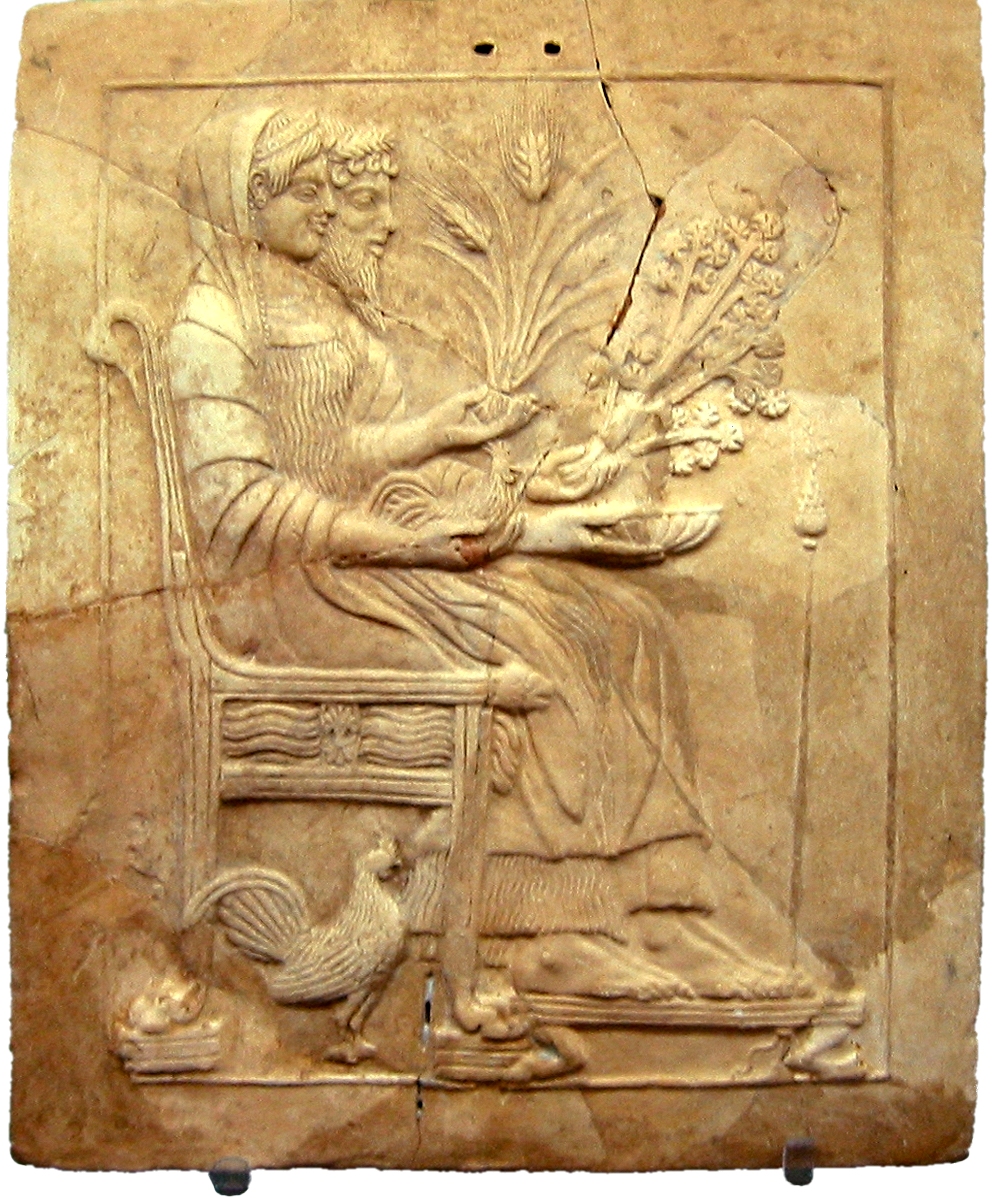.

Pinax of Persephone and Hades on the throne, found in the holy shrine of Persephone at Locri in the district Mannella. Locri was part of Magna Graecia and is situated on the coast of the Ionian Sea in Calabria, Italy: image by AlMare, September 2002 (Museo Nazionale Archeologico, Reggio Di Calabria, Italy)
Ripe are, dipped in fire, cooked
The fruits and proved upon the earth and an Order it is
That all must enter in, as snakes,
Prophetic, dreaming upon
The hills of heaven. And much
As on the bent shoulders
A load of logs
Must be retained. But evil are
The ways. For errantly
Like wild horses, run the constrained
Elements and the ancient
Orders of the earth. And always
Toward unboundedness goes out longing. Much however must
Be retained. And fidelity is required.
Forward however nor back will
We look. And allow ourselves to be rocked, like
A light boat at sea.

Pinax of Persephone opening the "Liknon Mystikon", found and in the holy shrine of Persephone at Locri in the district Mannella. Locri was part of Magna Graecia and is situated on the coast of the Ionian Sea in Calabria, Italy: image by AlMare, September 2002 (Museo Nazionale Archeologico, Reggio Di Calabria, Italy)
While... Hölderlin's technique, which is tempered by Greek, is not lacking in boldly formed hypotactic constructions, still the parataxes are striking -- artificial disturbances that evade the logical hierarchy of a subordinating syntax. Hölderlin is irresistibly drawn to such constructions. The transformation of language into a serial order whose elements are linked differently than in the judgment is musiclike.
While... Hölderlin's technique, which is tempered by Greek, is not lacking in boldly formed hypotactic constructions, still the parataxes are striking -- artificial disturbances that evade the logical hierarchy of a subordinating syntax. Hölderlin is irresistibly drawn to such constructions. The transformation of language into a serial order whose elements are linked differently than in the judgment is musiclike.
-- Theodor Adorno: Parataxis: On Hölderlin's Late Poetry, a talk given at the annual conference of the Hölderlin-Gesellschaft, Berlin, 7 June 1963; revised version first published in Die Neue Rundschau, 1964; translated by Shierry Weber Nicholsen in Theodor Adorno: Notes to Literature, Volume Two, 1992
Friedrich Hölderlin: "Reif sind..." (Ripe are the fruits), Hymnal Draft for Mnemosyne (Third Version), 1803 or 1805/1806 [?], trans. by TC
Tom,
ReplyDeleteWhat a beautiful translation of this Holderlin poem ! (Here is what happened when I read it: I was reading along, forgot that I'd read "Holderlin: Reif sind" and thus imagined/assumed that you had written it (and that made sense), and then reread it (aloud) and then saw "trans. TC" at the bottom of the page, goodness (!). And framed by those two pictures (followed by the Adorno). . . .
"And always/ Toward unboundedness goes out longing."
7.11
grey white of fog against invisible top
of ridge, quail standing on pine branch
in foreground, sound of wave in channel
painting that had been, was
such as other picture
cuts across color, as image
which stops short, as
grey white of fog against top of ridge,
shadowed green pine on tip of sandspit
I carried this around with me all day yesterday and through the night, but it felt more like the poem and two images were following me around, subtly pushing me, pulling me , and sending me in certain directions I could easily process and others I couldn’t. I’m told that comparisons are invidious, but it reminded me (to the extent it reminded me of anything else) of Gene Clark’s song “Set You Free This Time.” When I studied ancient Greek art in art history graduate school, I wrote a paper about a carved stele depicting a seated woman, not dissimilar to these two reliefs. I cannot remember much about it, except that there was no mythological iconography. (I think it was a domestic scene; it might even have been associated with a grave.) What I remember strongly, however, were the various lines of direction and force coursing through the composition and how, like in these examples, they interacted with the transparent layers of carving.
ReplyDeleteThank you Steve and Curtis, sorry to be a bit slow in replying (under the weather, as it were... perhaps appropriately in the present leaden weather).
ReplyDeleteThe reliefs provide rare images symbolically representing the central motifs of the Eleusinian Mysteries, which, true to their name, were always a closely-kept secret; but we do know that the presences of Persephone and Demeter were central. Hölderlin's poem also in its own way explores the ambiance of these Mysteries, I suspect. Rites of fertility and a poetic metaphysics of Earth, perhaps. The difficulty of the syntax is at the heart of things here, so I have attempted to retain it, tortuous as the attempt may seem. The paratax is, as Adorno suggests, essentially musical in structure, and as such (happily) beyond the realm of analysis.
Tom,
ReplyDeleteLeaden skies indeed -- bricks wet, drops of water on tips of leaves. . . . Holderlin would have thrived here. . . .